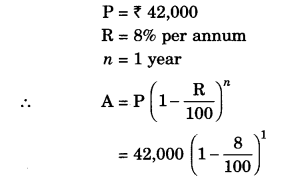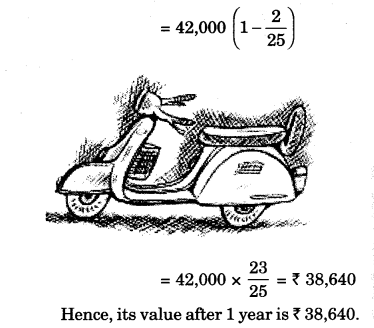Question 1.
Find ratio of the following:
- (a) Speed of a cycle 15 km per hour to the speed of scooter 30 km per hour.
- (b) 5 m to 10 km
- (c) 50 paise ? 5
Solution.
(a)
Speed of a cycle 15 km per hour to the speed of scooter 30 km per hour
Ratio of the speed of cycle which is 15 km per hour to the speed of scooter which is 30 km per hour
= 15 km per hour : 30 km per hour = 15 : 30
= 15/30=1/2 or 1 : 2
(b)
5 m to 10 km
10 km = 10 x 1000 m = 10000 m
∴ Ratio of 5 m to 10 km
= 5 m : 10 km
= 5 m : 10000 m
= 5 : 10000
= 510000=12000 or 1 : 2000
(c)
50 paise to ? 5
? 5 = 5 x 100 = 500 paise
∴ Ratio of 50 paise to ? 5
= 50 paise : ? 5
= 50 paise : 500 paise
= 50 : 500
= 50500=110 or 1 : 10
Question 2.
Convert the following ratios to percentages:
Solution.
(a) 3: 4
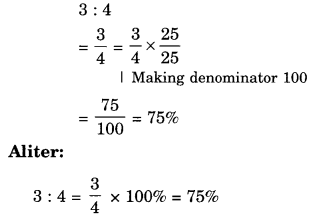
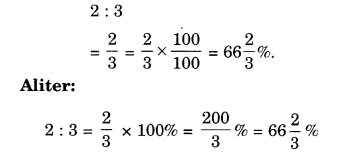
Question 3.
72% of 25 students are good in mathematics. How many are not good in Mathematics?
Solution.
Total number of students = 25
Students good in mathematics = 72%
∴ Students who are not good in mathematics
= (100 – 72)% = 28%
∴ Number of those students who are not good in mathematics
= 28% of 25
= 28/100×25=7
Hence, 7 students are not good in mathematics.
Question 4.
A football team won 10 matches out of the total number of matches they played. If their win percentage was 40, then how many matches did they play in all?
Solution.
∵ If 40 matches were won, then the total number of matches played = 100
∴ If 1 match was won, then the total number of matches played = 100/40
∴ If 10 matches were won, then the total number of matches played = 100/40×10=25
Hence, they played 25 matches in all.
Aliter: According to the question, 40% of (total number of matches) = 10
⇒ 40/100 x (total number of matches) = 10
⇒ Total number of matches = 10×100/40 = 25
Hence, they played 25 matches in all.
Question 5.
If Chameli had ? 600 left after spending 75% of her money, how much did she have in the beginning?
Solution.
Percentage of money left = (100 – 75)% = 25%
? If Chameli had ? 25 left, then the money she had in the beginning = 100
∴ If Chameli had ? 1 left, then the money she had in the beginning = 100/25
∴ If Chameli has ? 600 left, then the money she had in the beginning = 100/25×600=2400
Hence, the money she had in the beginning was ? 2400.
Aliter:
According to the question, 25% of total money = ? 600
⇒ 25/100 x total money = ? 600
⇒ Total money = ? 600×100/25 = ? 2400
Hence, the money she had in the beginning was ? 2400
Question 6.
If 60% of people in a city like a cricket, 30% like football and the remaining like other games then what percent of the people like other games? If the total number of people are 50 lakh, find the exact number who like each type of game.
Solution.
People who like other games = [100 – (60 + 30)]%
= (100 – 90)% = 10%.
Total number of people = 50 lakh
= 5000000
∴ Number of people who like cricket = 60% of 5000000
= 5000000 x 60/100
= 3000000 = 30 lakh
Number of people who like football = 30% of 5000000
= 5000000 x 30/100
= 1500000 = 15 lakh
Number of people who like the other games
= 10% of 5000000
= 5000000 x 10/100
= 5,00,000 = 5 lakh
Question 1.
A man got a 10% increase in his salary. If his new salary is f1,54,000, find his original salary.
Solution.
100 + 10 = 110
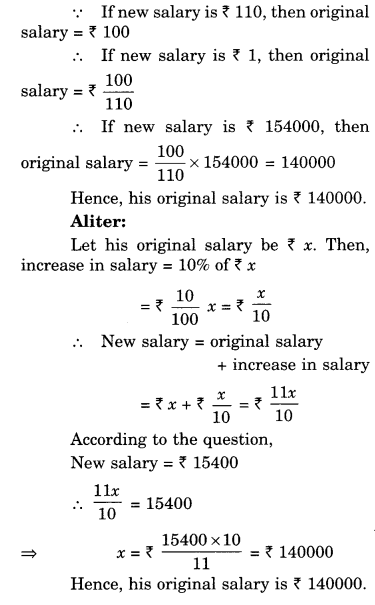
Question 2.
On Sunday 845 people went to the Zoo. On Monday only 169 people went. What is the percent decrease in the people visiting the Zoo on Monday?
Solution.
Number of people who went to Zoo on Sunday = 845
Number of people who went to Zoo on Monday = 169
∴ Decrease in the number of people who went to Zoo 845 – 169 = 676.
∴Per cent decrease in the number of people visiting the Zoo on Monday

Question 3.
A shopkeeper buys 80 articles for ? 2,400 and sells them for a profit of 16%. Find the selling price of one article.
Solution.
CP of 80 articles = ? 2400
Profit = 16% of ? 2400
= ? 16/100×2400 = ? 384
∴SP of 80 articles
= CP + Profit
= ? 2400 + ? 384
= ? 2784
∴ SP of 1 article = ? 2784/80 = ? 34.80
Hence, the selling price of one article is ? 34.80.
Question 4.
The cost of an article was ? 15,500, ?450 were spent on its repairs. If it is sold for a profit of 15%, find the selling price of the article.
Solution.
CP of the article = ? 15,500
Money spent on its rapair = ? 450
Total CP of the article = ? 15,500 + ? 450
(overhead expenses)
= ? 15,950
Profit = 15% of ? 15,950
= ? 15/100×15,950 = ? 2392.50
.-. SP of the article
= CP + Profit
=? 15,950 + ? 2392.50
= ? 18342.50
Hence, the selling price of the article is ? 18342.50.
Question 5.
A VCR and TV mere bought for ? 8,000 each. The shopkeeper made a loss of 4% on the VCR and a profit of 8% on TV. Find the gain or loss percent on the whole transaction.
Solution.
Combined CP of VCR and TV
= ? 8,000 + ? 8,000 = ? 16,000


Question 6.
During a sale, a shop offered a discount of 10% on the marked prices of all the items. What would a customer have to pay for a pair of jeans marked at ? 1450 and two shirts marked at ? 850 each?
Solution.
For a pair of jeans
Marked price = ? 1450
Discount rate = 10%
Discount = 10% of ? 1450
= ? 10/100×1450 = ? 145
∴ Sale price = Marked price – Discount
= ? 1450- ? 145 = ? 1305
For two shirts
Marked price = ? 850 x 2 = ? 1700
Discount rate = 10%
∴ Discount
= 10% of ? 1700
? 10/100×1700 x 1700 = ? 170
∴ Sale price
= Marked price – Discount
= ? 1700 – ? 170 =? 1530
Total payment made by customer
= ? 1305 + ? 1530 = ? 2835
Hence, the customer will have to pay ? 2835 for a pair of jeans and two shirts.
Question 7.
A milkman sold two of his buffaloes for ? 20,000 each. On one he made a gain of 5% and on the other a loss of 10%. Find his overall gain or loss. (Hint: Find CP of each.)
Solution.
Combined SP
= ? 20,000 x 2 = ? 40,000
For first buffalo
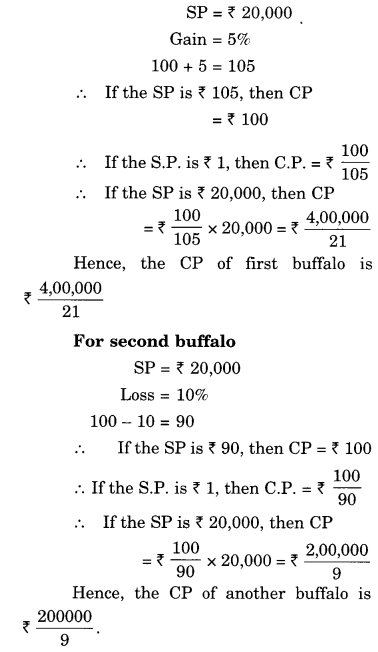
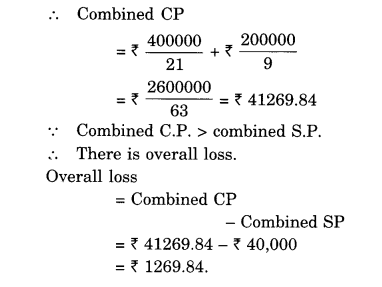
Question 8.
The price of a TV is ? 13,000. The sales tax charged on it is at the rate of 12%. Find the amount that Vinod will have to pay if he buys it.
Solution.
Price of TV = ? 13,000
Sales tax charged on it
= 12% of ? 13,000
= ? 12/100×13,000 = ? 1560
∴ Amount to be paid
= Price + Sales Tax
= ? 13,000 + ? 1,560
= ? 14,560.
Hence, the amount that Vinod will have to pay for the TV if he buys it is ? 14,560.
Question 9.
Arun bought a pair of skates at a sale where the discount is given was 20%. If the amount he pays is ? 1,600, find the marked price.
Solution.
Amount paid = ? 1600
Discount rate = 20%.
100 – 20 = 80
∵ If amount paid is ? 80, then the marked price = ? 100
∴ If amount paid is ? 1, then the marked price = ? 10080
∴ If amount paid is ? 1600, then the marked price = 10080×1600 = ? 2000
Hence, the marked price of the pair of skates is ? 2000.
Aliter:
Let the market price of the pair of shoes be ? 100.
Rate of discount = 20%
∴ Discount = 20% of ? 100
= 20/100×100 = ? 20
∴ Sale price = Marked price – Discount
= ? 100 – ? 20 = ? 80
∵ If the sale price is ? 80, then, the marked price = ? 100
∴ If the sale price is ? 1, then the marked price = ? 100/80
∴ If the sale price is ? 1600, then the marked price = ? 100/80×1600 = ? 2000
Hence, the marked price of the pair of shoes is ? 2000.
Question 10.
I purchased a hair-dryer for ? 5,400 including 8% VAT. Find the price before VAT was added.
Solution.
Price of hair-dryer including VAT = ? 5400
VAT rate = 8%
100 + 8 = 108
∵ When price including VAT is ? 108,
original price = ? 100
∴ When price including VAT is ? 5,400,
original price = ? 100/108×(5,400) = ? 5,000
Hence, the price before VAT was added is ? 5,000.
Question 1.
Calculate the amount and compound interest on

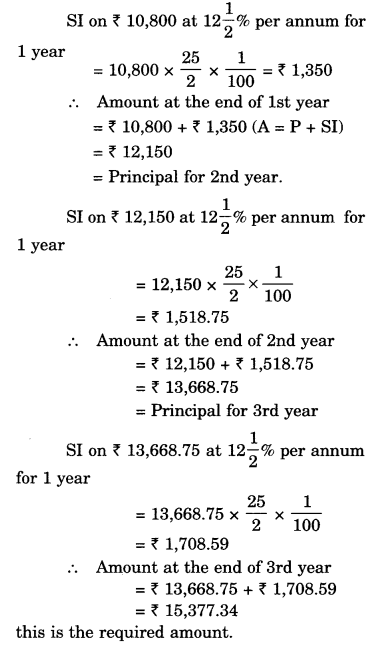
Solution.
(a) By using year by year calculation

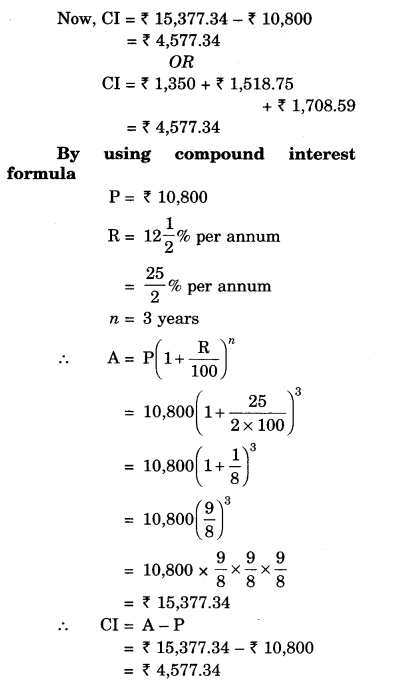

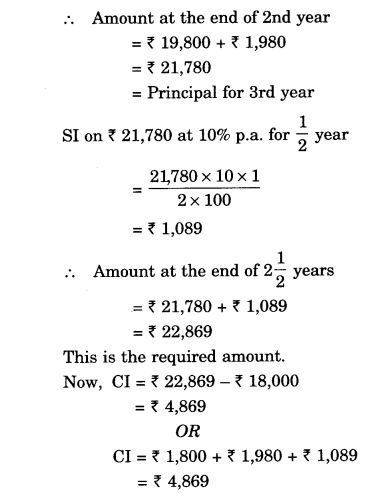
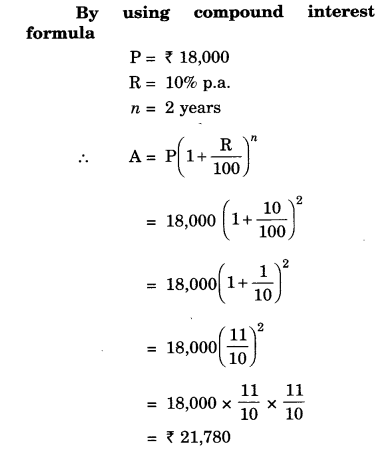
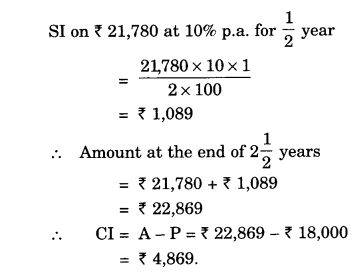
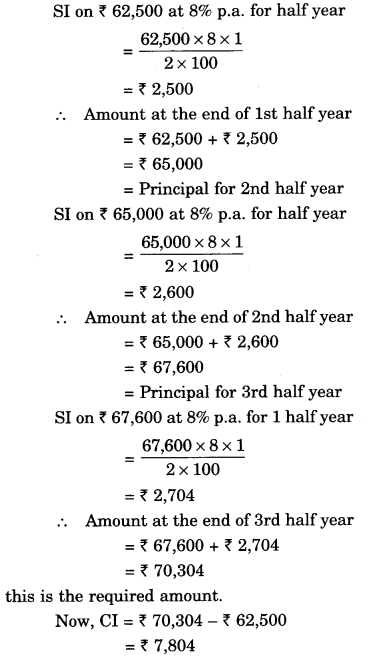
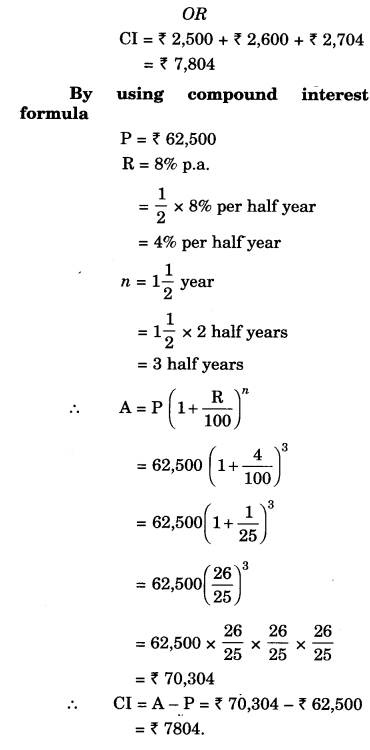
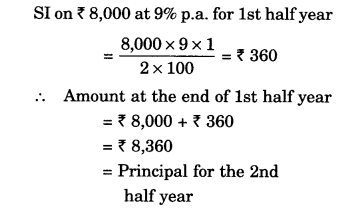
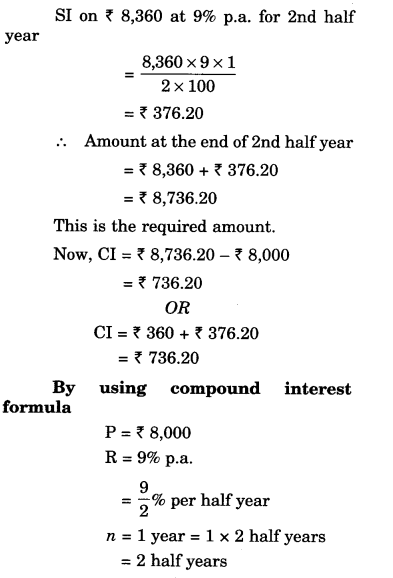
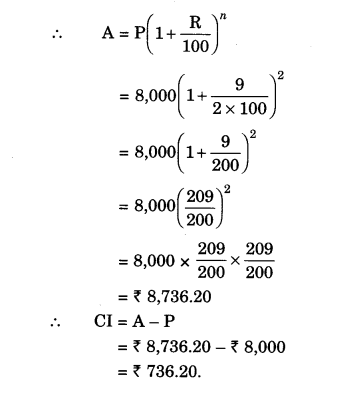
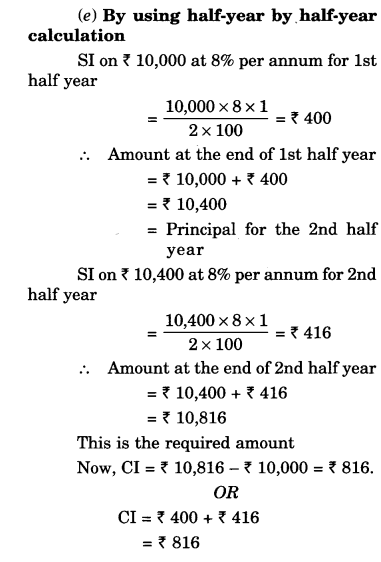
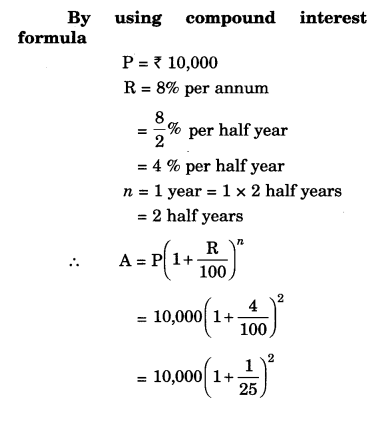
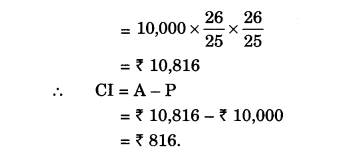
Question 2.
Kamala borrowed ? 26,400 from a Bank to buy a scooter at a rate of 15% p.a. compounded yearly. What amount will she pay at the end of 2 years and 4 months to clear the loan?
(Hint: Find A for 2 years if interest is compounded yearly and then find SI on the 2nd year amount for 4/12 year)
Solution.
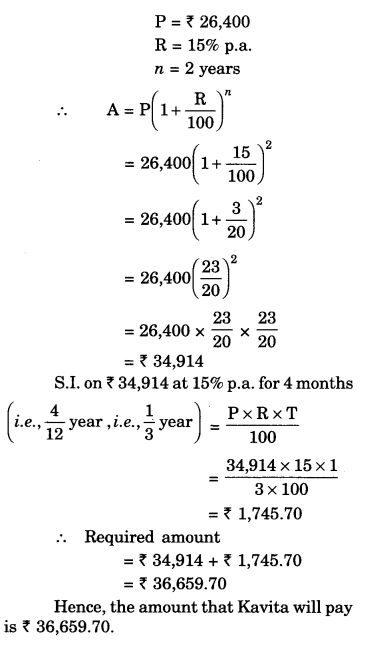
Question 3.
Fabina borrows ? 12,500 at 12% per annum for 3 years at simple interest and Radha borrows the same amount for the same time period at 10% per annum, compounded annually. Who pays more interest and by how much ?
Solution.
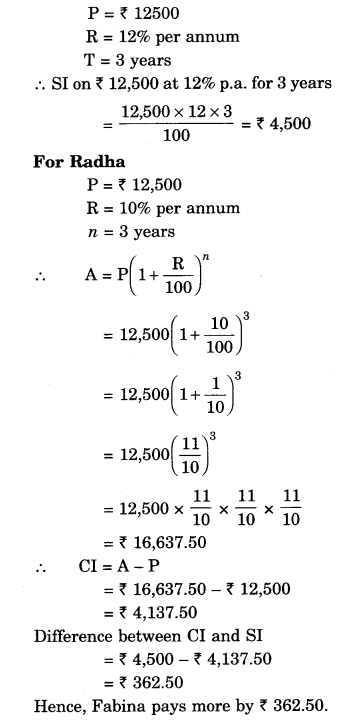
Question 4.
I borrowed ? 12,000from Jamshed at 6% per annum simple interest for 2 years. Had I borrowed this sum at 6% per annum compound interest, what excess amount would I have to pay?
Solution.
At simple interest
P = ? 12000
R = 6% per annum
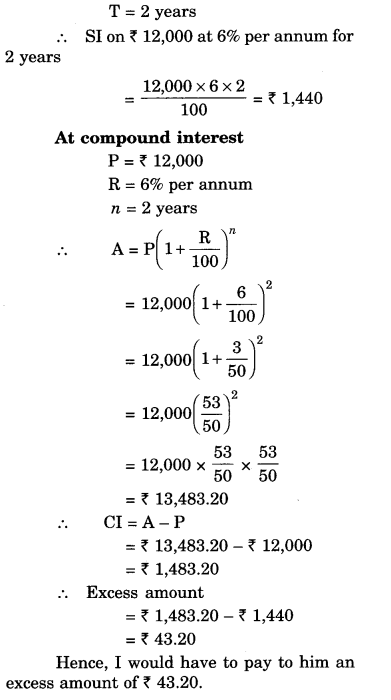
Question 5.
Vasudevan invested ? 60,000 on interest at the rate of 12% per annum compounded half yearly. What amount would he get
- (i) after 6 months?
- (ii) after 1 year?
Solution.
(i) after 6 months
P = ? 60,000
R = 12% per annum
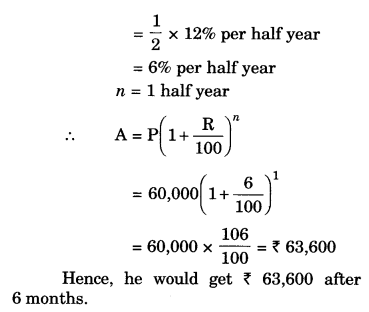
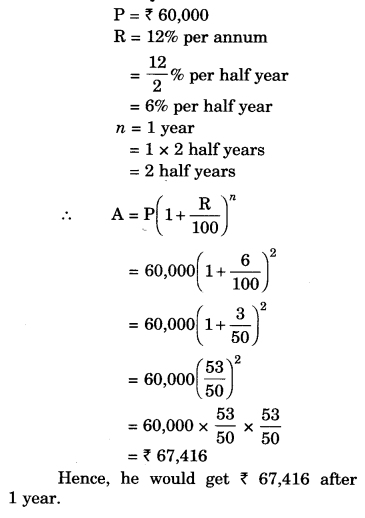
Question 6.
Arif took a loan of ? 80,000 from a bank. If the rate of interest is 10% per annum, find the difference in amounts he would be paying after 1 1/2 years if the interest is
- (i) compounded annually
- (ii) compounded half yearly
Solution.
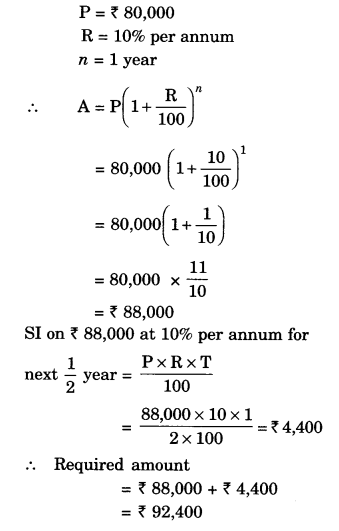
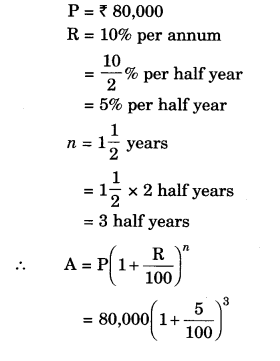
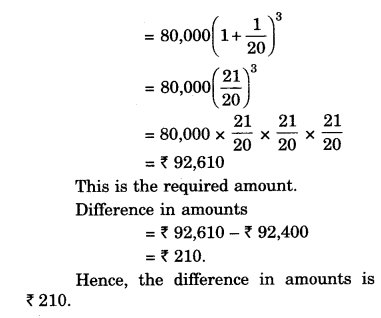
Question 7.
Maria invested ? 8,000 in business. She would be paid interest at the rate of 5% per annum compounded annually. Find
(i) the amount credited against her name at the end of the second year.
(ii) the interest for the 3rd year.
Solution.
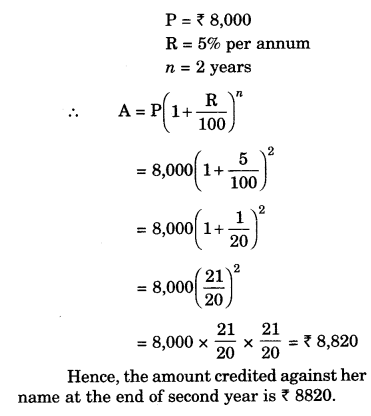
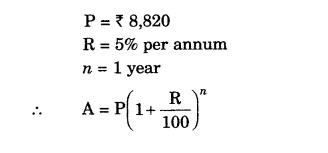
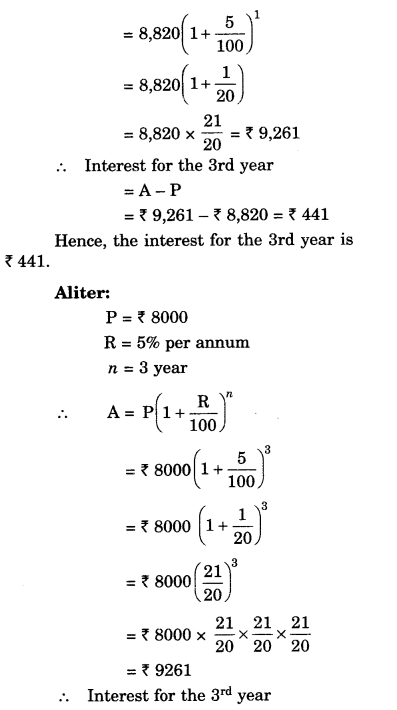
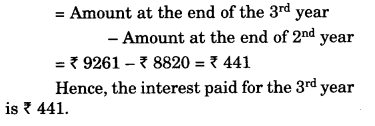
Question 8.
Find the amount and the compound interest on ? 10,000 for 1 1/2 years at 10% per annum, compounded half yearly. Would this interest be more than the interest he would get if it was compounded annually?
Solution.
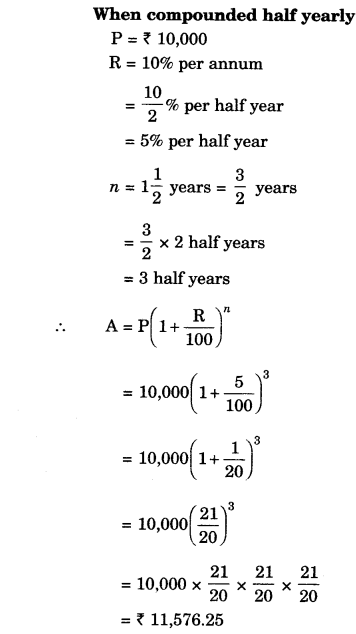

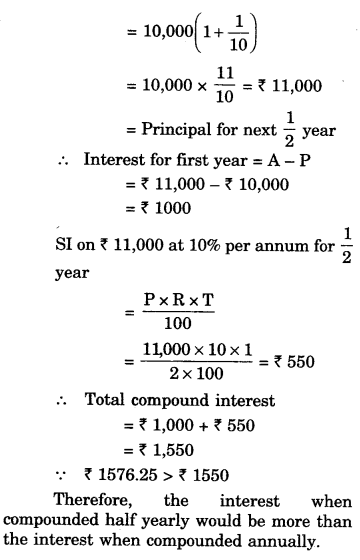
Question 9.
Find the amount which Ram will get on ? 4,096 if he gave it for 18 months at 1212 per annum, interest being compounded half yearly.
Solution.
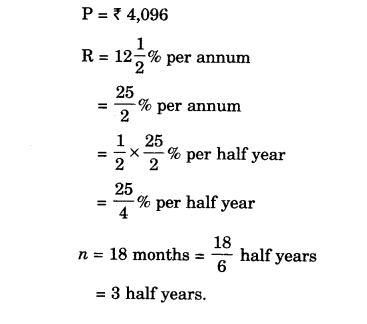
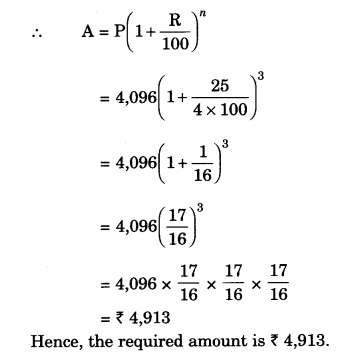
Question 10.
The population of a place increased to 54,000 in 2003 at a rate of 5% per annum.
- (i) find the population in 2001.
- (ii) what would he its population in 2005?
Solution.
(i)
Let the population in 2001 be P.
R = 5% p.a.
n = 2 years
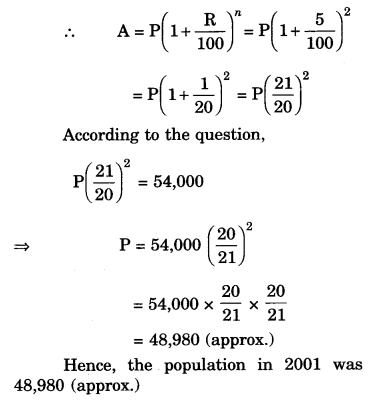
(ii)
initial population in 2003
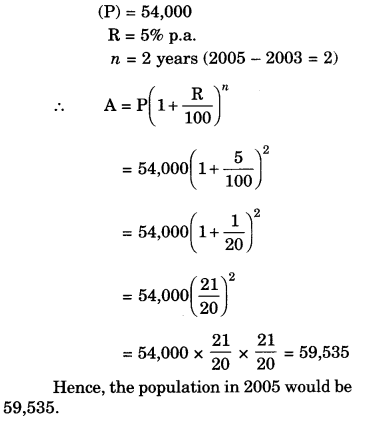
Question 11.
In a Laboratory, the count of bacteria in a certain experiment was increasing at the rate of 2.5% per hour. Find the bacteria at the end of 2 hours, if the count was initially 5,06,000.
Solution.
Initial count of bacteria
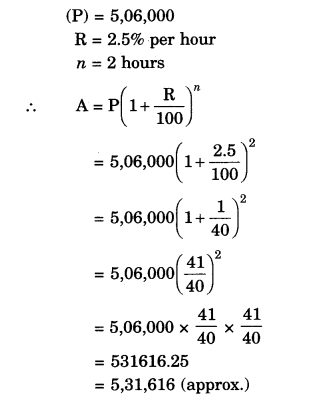

Question 12.
A scooter was bought at ? 42,000. It’s value depreciated at the rate of 8% per annum. Find its value after one year.
Solution.
Initial value of the scooter
